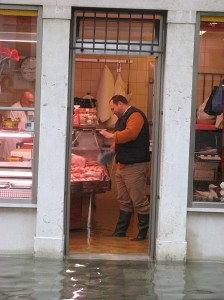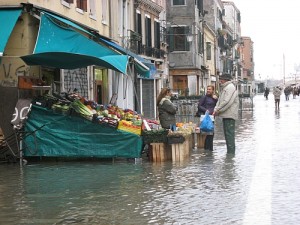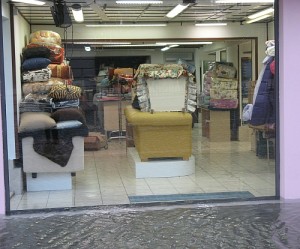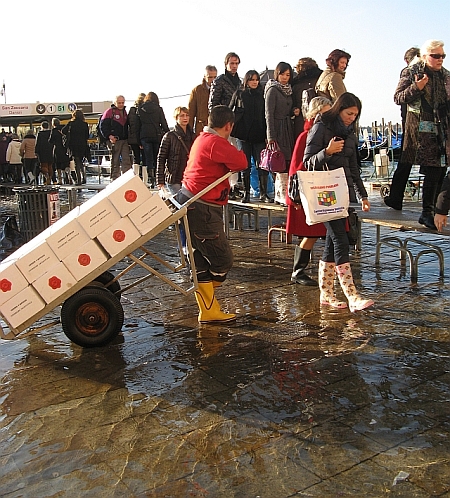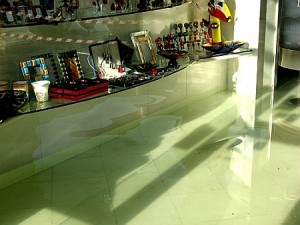As I may have intimated, we didn’t plan on being in the Piazza San Marco at the stroke of midnight, and we in fact stayed home until midnight when we walked out to the waterfront to watch the fireworks over the Bacino of San Marco.

This isn’t to say that our neighborhood was empty — au contraire. There were plenty of kids out, and assorted adults, and the kids, at least, were intent on making things explode. Here these variations on the firecracker are generically called petardi (a petardo here is not something you would be want to be hoist with, even if it was your own) and they make a seriously loud bang and leave black smears on the street.
The first things to be called “petard,” I discover, were not used for entertainment. They were small bombs used to breach walls and blow in doors. The term derives from Middle French and/or Latin, from the word invented long before gunpowder to mean “fart.”
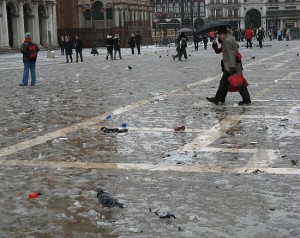
But turning to more serious detonations, you probably know that Thomas Carlyle famously said that “The three great elements of modern civilization are gunpowder, printing, and the Protestant religion.” My calculation is that there is an inverse relationship between the quantity of gunpowder in a place or time and the quantity of civilization represented thereby. I understand that fireworks to mark the birth of a new calendar are common in many places and cultures and are loaded with symbolic meaning. I only wanted to remark that I myself don’t regard pain and mutilation as being especially civilized, no matter what else your culture may have discovered or invented.
Here is the New Year’s morning balance sheet from the merrymaking that involved things that go boom in Italy:
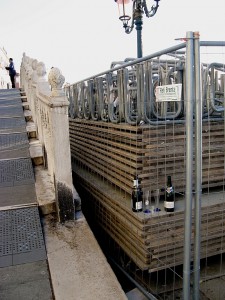
500 people wounded (four of them seriously, and 68 under the age of 12), and one person killed, almost exclusively by fireworks of the homemade variety, some of which could create explosions rivaling those we read about occurring in foreign marketplaces. It’s too bad that my first reaction when I read that was “Great! Only one person died!” It’s nothing to be pleased about, especially when I learned that he was killed by a stray bullet when he went out in the courtyard with his friends to watch the fireworks. Guns are becoming a new way here to make noise and threaten life to welcome the next 12 months.
And various people have lost eyes and hands. It’s the same every year.
At San Marco, at least, there were no damaging cannonades. The mass celebration there seems to have gone without any particular hitch (or lost dogs). The reports describe its dimensions:
60,000 people went to the Piazza to drink Prosecco (or whatever they brought), watch the fireworks, and share a kiss at midnight. I’m not going to try to calculate how tightly these people were packed together; the Piazza is big, but not unusually big, and I can imagine that once they locked lips it took some time for there to be enough space to unlock them again. Concerning the clip below, unless you’re a total crowd-and-fireworks maniac, skip to the last two or three minutes. Just a suggestion.
As for trash (here the Countryside Code doesn’t apply — people don’t mind leaving their footprints and garbage behind), there was plenty. To festivize properly seems to require discarding material, kind of like the solid rocket boosters falling away from the Space Shuttle at T plus two minutes.
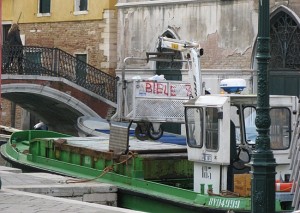
At 2:30 AM the trash collectors took over — 120 of them, filling 140 garbage “wagons” (or 104, the accounts aren’t consistent, but anyway, 40 wagons were loaded in the Piazza alone), the contents of all of which were dumped into 40 garbage barges. By 5:00 AM the Piazza was clean again and I give everybody loads (two bargefuls) of compliments.
What was left behind in our little hovel was not smashed bottles or busted firecrackers, but there are still large amounts of great food sitting around, including homemade cake and cookies, which are going to make that New Year’s Resolution — you know the one I mean — that much harder to fulfill.
But I’m feeling hopeful about virtually everything at the moment, which is an inexplicable but very welcome byproduct of starting a new year, not to mention a new decade, and I’m going to try to make it last as long as I can. The feeling, I mean. Not the year.


 After you had reveled in your Lucullan repast, you could have gone around the corner to the Piazza San Marco not only to watch the fireworks but create your own (metaphorically speaking) by throwing in your osculatory lot with all the other couples thronging the piazza who have been primed by weeks of publicity to come here to kiss each other at midnight.
After you had reveled in your Lucullan repast, you could have gone around the corner to the Piazza San Marco not only to watch the fireworks but create your own (metaphorically speaking) by throwing in your osculatory lot with all the other couples thronging the piazza who have been primed by weeks of publicity to come here to kiss each other at midnight.
